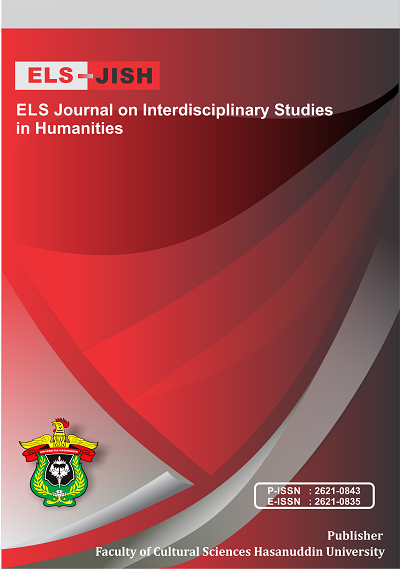Code-Switching Varieties in Syrian Community
(A Case Study in Syria and Turkey)
DOI:
https://doi.org/10.34050/elsjish.v5i2.21531Keywords:
Code-switching, Multilingualism, PatternsAbstract
The main focus of this study is the way code-switching is used in the Syrian community. The study is designed to examine the patterns of code-switching in communication among the young generation and adults as well. It encompasses bilingual and multilingual Syrian participants, young and adult, both in Syria and Turkey. Therefore, factors like migration experience and age will be explored. For this purpose, data are taken from conversations with participants via voice calls; all recorded conversations were transcribed and transliterated to clarify the code-switching patterns. The Mixed Methods Approach to analyze participants’ data based on Muysken's code-switching typology and the three-way division is adopted. The findings yielded that 7 participants exhibited no code-switching at all versus 9 who did and that the insertional division is the one prevailing in almost all instances of code-switching. The results suggest that age is a prominent factor in the process of CS, while cultural exposure is not. It is also observed that although a small difference is detected between genders, it is not an affecting one.
References
Barber, Carroll G. (1973). Trilingualism in an Arizona Yaqui Village. In Turner, Raul R. (Eds.), Bilingualism in the Southwest, 295-319.Tuscan:University of Arizona Press.
Christodoulou-Pipis, I. (1991). Language use by Greek-Cypriots in Britain. Nicosia: Diaspora Books.
Chun, E. (2001). The Construction of white, black and Korean. A merican Identities through African American Vernercular English. Journal of Linguistic Anthropology, 11(1) 127-128. doi: https://doi.org/10.1525/jlin.2001.11.1.52
Clyne, Michael G. (1987). Constraints on code-switching: How universal are they? Linguistics 25, 739-764. doi: https://doi.org/10.1515/ling.1987.25.4.739
Creswell, J. (2003). Research Design: Qualitative, Quantitative, and Mixed Methods Approaches. London: Sage
Dabene, Louise. & Daniele Moore, D. (1995). Bilingual Speech of migrant people. In Milroy, Lesley & Pieter Muysken (Eds.), One speaker two languages: cross disciplinary perspectives on code- switching, 17-44. Cambridge: Cambridge University Press.
Edwards, J.V. (2004). Foundations of bilingualism. In T.K. Bhatia & W.C. Ritchie (Eds.), The handbook of bilingualism (7-31). Oxford, UK: Blackwell.
Eid, Mushira. (1992). Directionality in Arabic-English code-switching. In Rouchdy, Aleya (Eds), The Arabic language in America: A sociolinguistic study of a growing bilingual community, 50-71. Detroit: WayneState University Press.
Eres, F., & Aslan, F. (2017). Analysis of Leisure Time Activities of Syrian Children in Turkey as an Adaptation Process. Journal of Education and Practice, 8(15), 76-84.
Fishman, J. A. (1997). Reversing Language Shift. (1st Ed). Clevedon, Bristol: Multilingual Matters.
Gardner-Chloros, Penelope. (2009). Code-Switching. Cambridge: Cambridge University Press.
Grosjean, François. (1982). Life with two languages: an introduction to bilingualism. Cambridge, Mass: Harvard University Press
Hoffman, C. (1991). An introduction into bilingualism. London: Longman.
Jones, M., & Jones, K. E. (Eds.). (2001). Multilingual literacies: Reading and writing different worlds (Vol. 10). John Benjamins Publishing.
Karanfil, F., & Demir, S. (2021). Multilingual identity development in a trilingual setting: A case study of refugee identity and language use. Journal of Language and Linguistic Studies, 17(3), 866–883. doi: https://doi.org/10.17263/jlls.904078
Matras, Y. (2009). Language Contact. Cambridge: Cambridge University Press.
Mesthrie, R. (ED.). (2011). The Cambridge Handbook of Sociolinguistics. Cambridge: Cambridge University Press.
Milroy, L. & Muysken, P (1995). Introduction: Code-switching and bilingualism research. In Lesley Milroy & Pieter Muysken (Eds.), One speaker, two languages: cross-disciplinary perspectives on code-switching, 1-14. Cambridge: Cambridge University Press.
Mugo, K. C. (2017). Forms of Matrix Language + Embedded Language Formula in Code Switching instances. nternational Journal of Academic Research in Business and Social Sciences, 7(1), 61–71. doi: https://doi.org/10.6007/IJARBSS/v7-i1/2572
Muysken, P. (2000). Code-mixing, bilingual speech and language change. Bilingual Speech_ A Typology of Code- Mixing, 1995, 250–262. doi: https://10.1017/S0022226703272297
Myers-Scotton, C. (1993). Duelling Languages. Grammatical Structure in Codeswitching. Oxford: Clarendon Press.
Myers-Scotton, C. and Jake, J.L. (1995). Matching lemmas in a bilingual language competence and production model:evidence from Intrasentential Codeswitching. Linguistics, 33 :981-1024.
doi: https://doi.org/10.1515/ling.1995.33.5.981
Myers-Scotton C. (2002). Contact Linguistics: Bilingual Encounter and Grammatical Outcomes. Oxford: Oxford University Press
Nafa, H. Ben. (2013). Code-Switching Among Arabic-English Adult Bilinguals in the UK : Syntactic Structures , and Pragmatic Functions. (Master’s thesis). The University of Manchester, England.
Nilep, C. (2006). “Code Switching” in Sociocultural Linguistics. Colorado Research in Linguistics, 19(6), 1–22.doi: https://doi.org/10.25810/hnq4-jv62
Othman, A. (2006). Language choice among Arabic-English bilinguals in Manchester. (Unpublished MA dissertation). University of Manchester, England.
Poplack, S. (1980). Sometimes I’ll start a sentence in Spansih y termino en español: Towards a Typology of Code-switching. Linguistics, 18, 581-618. doi: https://10.1515/ling.1980.18.7-8.581
Pfaff, C. (1979). Constraints on language mixing: intrasentential code switching and borrowing in Spanish/ English. Language 55, 2, 291 – 318. doi: https://10.2307/412586
Silva, C. (1994). Language contact and change. New York: Clarendon press.
Wei, L. (1998). The ‘why’ and ‘how’ questions in the analysis of conversational codeswitching. In P.Auer (Eds), Code-switching in conversation: Language, interaction and identity, 156-176. London: Routledge.
Wei, L. (2000). The Bilingualism Reader. London: Routledge.
Wei, L. (2013). Conceptual and methodological issues in bilingualism and multilingualism research. The handbook of bilingualism and multilingualism, 2, 26-53. doi: https://10.1002/9781118332382.ch2
Downloads
Published
How to Cite
Issue
Section
License
Copyright (c) 2022 Nouran Alfashtakie, Mohammad Umar Muslim

This work is licensed under a Creative Commons Attribution-NonCommercial-ShareAlike 4.0 International License.






